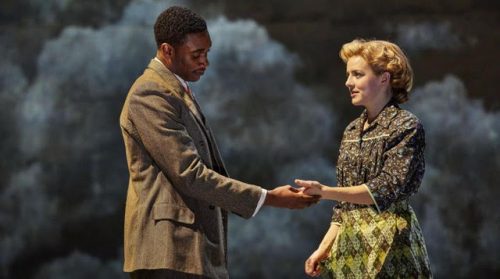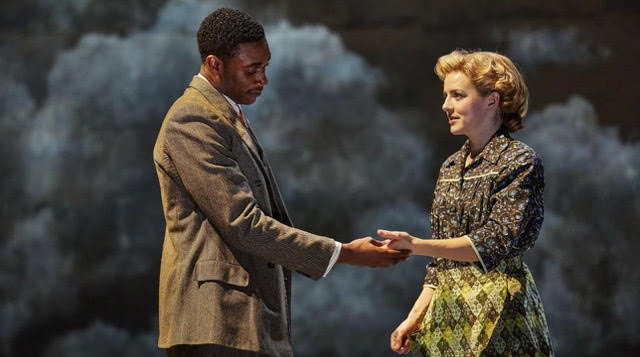
 United Kingdom National Theatre at Home – Helen Edmundson’s adaptation of Andrea Levy’s Small Island: filmed live on stage at the National Theater in May 2019 and viewed on 24.6.2020. (RP)
United Kingdom National Theatre at Home – Helen Edmundson’s adaptation of Andrea Levy’s Small Island: filmed live on stage at the National Theater in May 2019 and viewed on 24.6.2020. (RP)
Production:
Director – Rufus Norris
Sets and costumes – Katrina Lindsay
Projection – Jon Driscoll
Lighting – Paul Anderson
Composer – Benjamin Kwasi Burrell
Sound – Ian Dickinson for Autograph
Movement director – Coral Messam
Fight director – Kate Waters
Music consultant – Gary Crosby
Director for screen – Tony Grech-Smith
Cast:
Mrs Ryder – Amy Forrest
Hortense – Leah Harvey
Miss Jewel – Sandra James-Young
Little Hortense – Keira Chansa
Mr Philip/GI/Kenneth – Trevor Laird
Miss Ma – Jacqueline Boatswain
Little Michael – Shaquahn Crowd
Michael – CJ Beckford
Policeman/GI – Natey Jones
Woman in Hurricane – Chereen Buckley
Bernard – Andrew Rothney
Queenie – Aisling Loftus
Aunt Dorothy/Woman with Baby – Beatie Edney
Mr Buxton/Ginger/Sergeant Thwaites/Railway Worker – Adam Ewan
Young Main in Sweet Shop/Kip/GI/Railway Worker – Cavan Clarke
Arthur – David Fielder
Franny – Phoebe Frances Brown, Rebecca Lee
Gilbert – Gershwyn Eustache Jnr
Recruiting Officer One/Soames/Railway Worker/Military Policeman – Paul Bentall
Elwood – Johann Myers
Recruiting Officer Two/GI/Foreman – John Hastings
Usherette – CJ Johnson
GI – Daniel Norford
Celia – Shiloh Coke
Art often has a way of not only being ahead of its time but also, years later, unexpectedly and exactly in the moment, as is the case with the National Theatre at Home’s Small Island. Andrea Levy’s 2004 novel is undoubtedly better known in the UK (the BBC adapted the prize-winning book for television in 2009), than it is on this side of the Atlantic. It’s a story of war, dreams, humanity and that tricky issue of race that is upending much of the developed world at the moment. You could plop the plot of Small Island down into America anytime from the end of World War II until the present, and it would ring just as true, but Levy writes of what she knows – the story of Jamaican immigrants in England.
Levy was born in London to Jamaican parents who came to Britain in 1948; her father sailed on the troopship HMT Empire Windrush, and her mother joined him soon after. Her novels relate the experiences of blacks in Britain, and examine immigration to the UK and its complex history with its former colonies in the Caribbean.
Although British readers will need no introduction to the historical backdrop of Small Island, others might. On 21 June 1948, the Windrush arrived in England carrying hundreds of passengers from the Caribbean who hoped to begin a new life at a time when there were postwar labor and housing shortages as well as rationing. The ship gave its name to a wave of immigration, known as the ‘Windrush Generation’, that lasted until 1971. It was also the year that Commonwealth citizens who were already living in the UK were granted indefinite leave to remain.
In 2018, it emerged that some of the Windrush migrants had been threatened with deportation; denied access to NHS treatment, benefits and pensions; and stripped of their jobs. Prime Minister Theresa May’s government was forced to apologize and offered compensation to anyone who had suffered loss. The National Theatre’s week-long streaming of Small Island coincided with the annual observance of Windrush Day, which was held this year on 22 June.
Playwright Helen Edmundson had the benefit of a strong book in crafting the stage version of Small Island. Although it obviously isn’t a musical, in many ways Small Island reminded me of Rodgers and Hammerstein’s South Pacific. The American masters based their 1949 hit musical on James A. Michener’s Pulitzer Prize–winning book, Tales of the South Pacific. Both plays are set during World War II, which infuses a certain similar sensibility in both, but more importantly, Rodgers and Hammerstein and the creative team responsible for Small Island both sought to send a strong progressive message on racism to theater audiences.
Like South Pacific, Small Island has characters that are all too human in their imperfections. Hortense (the radiant Leah Harvey) whose light skin portends that she will lead a golden life, flees Jamaica with dreams of being a school teacher in England. Her snobbishness, refined manners and command of the King’s English, which is all but incompressible to the denizens of Earl’s Court, make for a rocky start to her new life.
Hortense’s ticket to England was marriage to Gilbert, who has aspirations of his own that are buffeted by reality. His dream is to become a lawyer, but he toils as a delivery man, subject to the racial taunts of his coworkers. Gershwyn Eustache Jnr delivers Gilbert’s stirring plea for racial tolerance, the emotional highpoint of Small Island, with soaring eloquence and passion.
Queenie, portrayed by the glowing Aisling Loftus, serves as the emotional linchpin of the play. She escapes the drudgery of life on a pig farm only to end up in a soulless marriage to Bernard, an odd duck who loves his wife in his own way. Bernard, played to aloof, clueless perfection by Andrew Rothney, goes off to fight in the war and then goes missing.
During his absence Queenie experiences a sexual awakening with Michael, played by the dashing CJ Beckford – a scamp, soldier and Hortense’s beloved cousin, whom she describes in a breathtaking, rapturous soliloquy. Queenie also takes in Jamaican boarders, much to the consternation of her neighbors, and of her husband when he finally returns home. Bernard’s story as to his whereabouts during the three years is a bit dodgy, but Queenie has a secret also – she is pregnant with Michael’s child.
At the play’s end, Hortense and Gilbert are leaving Earl’s Court to move into a fixer-upper bombed during the war. They agree to take Queenie’s son, who is dark-skinned like his father, as his mother realizes that it will be impossible for him, as well as for her, to live in peace in the world that she inhabits. Hortense is delighted that the boy is named Michael, a name that is very special to her. The dots aren’t connected, however, and the play ends with Hortense and Queenie unaware of the other bond that unites them.
It goes without saying that watching Small Island in June 2020 is a different experience than it would have been live at the National Theatre last May during its sold-out run. The play hasn’t changed, but we have. The comfortable gauze of nostalgia that envelopes the play has, to a large degree, evaporated due to events in America and elsewhere: there is talk of a racial reckoning and all the fuss about statues and history being erased.
You can’t erase history. It’s one rich, glorious tapestry of countless threads in an infinite array of colors. Theater works like Small Island make you look at a few threads or a scene in the tapestry afresh, or even perhaps for the first time. It’s history as real as anything you will read in a book or glean from looking at a statue.
And if history and introspection aren’t your thing, the current offering from the National Theatre at Home is Shakespeare’s A Midsummer Night’s Dream (for an earlier review click here).
Rick Perdian
For more about the National Theatre and NT at Home click here.
